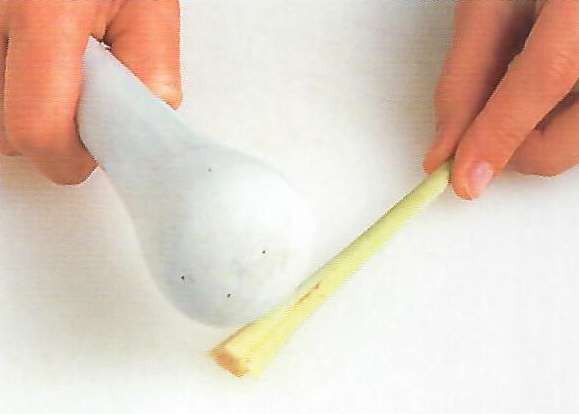Making a Lemon Grass Brush
Mandarin: Ningmeng Cao; Cantonese: Xiang Mao; Malay: Serai; Thai: Takrai Vietnamese: Xa.
Few ingredients have seized the Western imagination quite so dramatically as has lemon grass in recent years. At one time this scented grass was little known outside South-east Asia; today it is to be found in nearly every supermarket.
Lemon grass is a perennial tufted plant with a bulbous base. It grows in dense clumps in tropical and subtropical countries and is commercially cultivated on a grand scale. The cut stems are about 20cm / 8in long, and look a little like fat spring onions or very skinny leeks.
Aroma and flavour
It is only when the stems are cut that the distinctive citrus aroma can be fully appreciated. This is matched by the clean, intense lemon flavour, which has a hint of ginger but none of the acidity associated with lemon or grapefruit.

Lemon rind is sometimes suggested as a substitute, but it lacks the intensity and liveliness of fresh lemon grass, and will give disappointing results.
Ground dried lemon grass, also known as serai powder, can be used instead of fresh. As a guide, about 5mI / 1 tsp powder is equivalent to 1 fresh stalk. Whole and dried chopped stalks are also available in jars from oriental stores, and larger supermarkets as are jars of lemon grass paste.
Culinary uses
Lemon grass is widely used throughout South¬east Asia, in soups, sauces, stir-fries, curries, salads, pickles and marinades. It is a perfect partner for coconut milk, especially in fish, seafood and chicken dishes. Thai cooks often start a stir-fry by adding a few rings of lemon grass and perhaps a little grated or chopped fresh root ginger or galangal to the oil. This not only flavours the oil, but also fills the room with a glorious aroma.
A favourite Vietnamese dish consists of sea bream coated in a lemon grass paste, which is left to stand until the flavour penetrates the fish, and then fried.

Preparation and cooking techniques
There are two main ways of using lemon grass. The stalk can be bruised, then cooked slowly in a soup or stew until it releases all its flavour and is removed, or the tender portions of the lemon grass (usually the lower 5cm / 2in of the bulbous end of the stem) can be sliced or finely chopped, then stir-fried or used in a salad or braised dish. Often one stalk will serve both purposes, the tougher top end is used for background flavouring while the tender portion forms the focal point of a dish. For basting food that is to be grilled or barbecued, the upper portion of another lemon grass stalk can be used. The fibrous end is flattened with a cleaver or pestle to make a brush.
Making a Lemon Grass Brush
Instead of discarding the dry stalk, make it into a basting brush.
 |
Trim off the bottom 5cm / 2in of the lemon grass stalk to use in a recipe, then flatten the cut end of the remaining stalk using a cleaver or pestle to produce a fibrous brush.
Storage
Store lemon grass stalks in a paper bag in the vegetable compartment of the fridge. They will keep for 2-3 weeks.